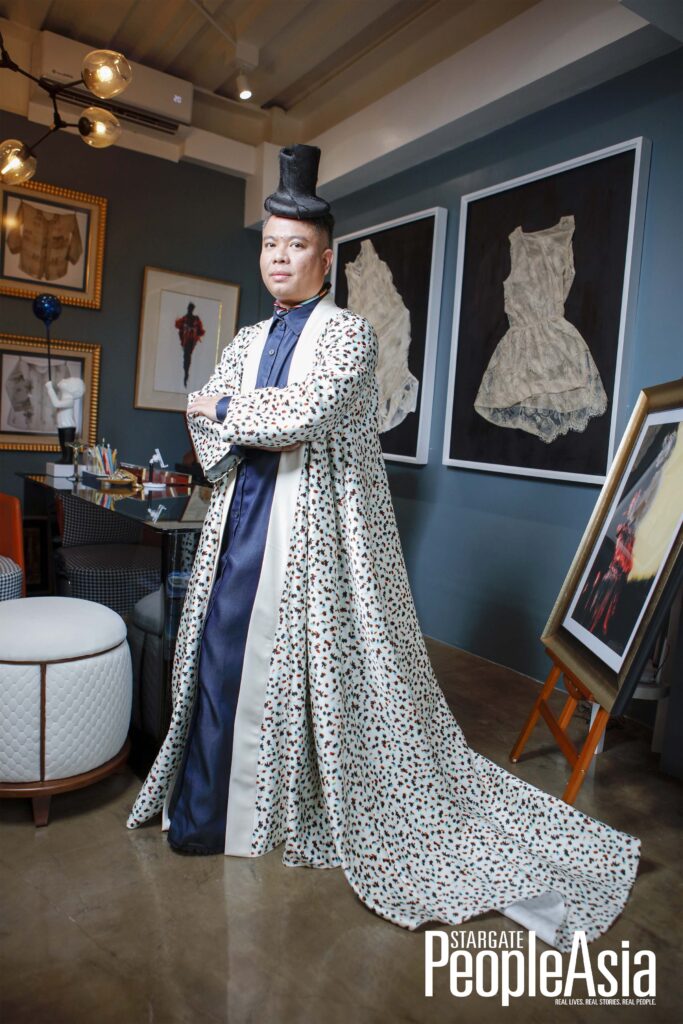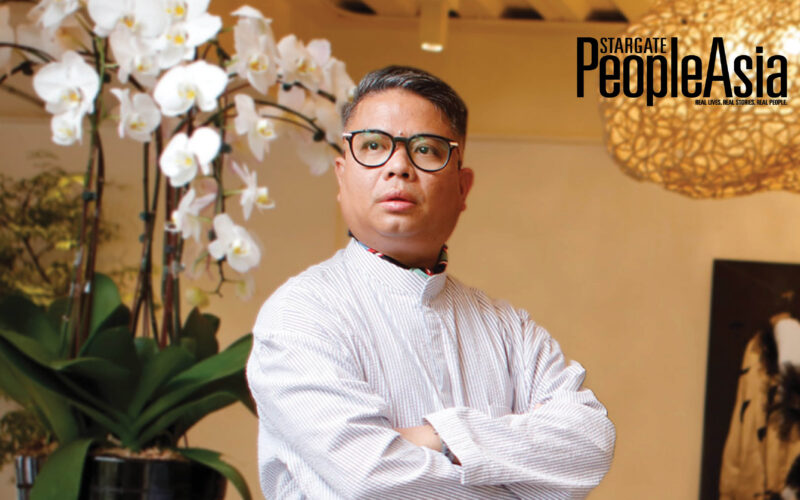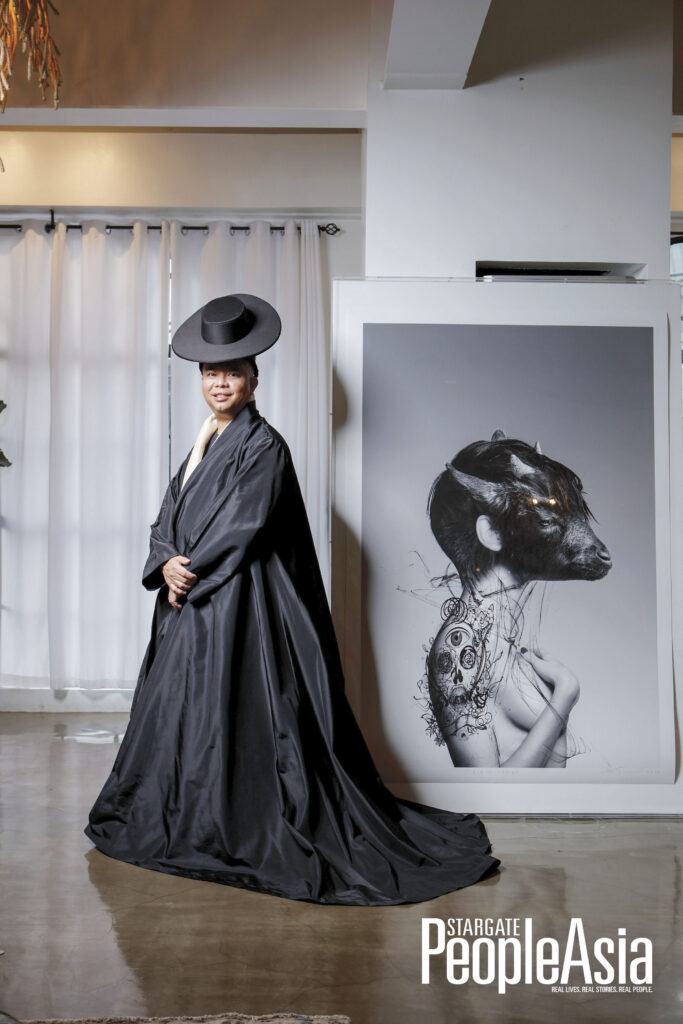BY ALEX Y. VERGARA
His was a classic story of redemption. Viewed another way, it also calls to mind the old saw that you can never put a good, talented man down — at least not forever.
Seeing Puey Quiñones basking in the applause of the event’s well-heeled audience led by First Lady Liza Araneta Marcos as he took a bow after his gala fashion show at the Goldenberg Mansion earlier this year, one can’t help but marvel at the development. To many, it was a testament not only to the designer’s ability to reinvent himself, but more so the resurrection of a career that was considered by many as all but dead after a fateful mistake he did in 2011.
It was also a classic story of redemption and the ability of, in Puey’s words, a “judgmental” public to give people like him a second chance. Viewed another way, it also calls to mind the classic saw that you can never put a good man down, especially one as talented and as driven as Puey.
“Filipinos tend to be judgmental,” he says. “But they also tend to easily forgive and forget.”
Now 43, Puey is back on every fashion-forward woman’s radar. The designer, who once hit rock-bottom, is now thriving, attending to not one but several enterprises based in Manila and Los Angeles. He also has a tastefully interior-designed shop in Poblacion, Makati catering to couture orders. A bridal shop in LA, dubbed as Q Bridal, which offers a range of options for would-be brides and a uniform-manufacturing business in Manila that addresses the demands of a growing corporate clientele, are also part of his burgeoning empire.
RTW and MTO
On top of these, Puey, with the help of Roland Magalang, his former boss at Bergamo, whom he has tapped as his company’s COO, recently opened a satellite shop at Rustan’s Makati offering RTW pieces and MTO services.
For someone who began his designing career in the mid aughts with one sewing machine and one sewer in a rented condo unit that doubled as his sleeping quarters by night, Puey is now on top of 100 people.
These days, Puey, a green card holder who’s married to American Paul Martineau, a curator at the Paul Getty Museum in LA, flies back and forth between the Philippines and the US once every two months or so.
“I don’t like spending days off. Even before, during my days off, I would always pass by my place of work just to see how things were going. I think I’d get sick if I didn’t go to work. The only time I get to fully relax is during long-haul flights,” Puey shares with PeopleAsia one afternoon at his shop in Poblacion.
That’s why even when he’s flying with family members and staff, he makes it a point to sit far away from them. “As a rule, Paul and I never travel together in one plane. Kasi daw pag nag-crash ang plane (because when the place crashes) no one would be left behind to take care of what we’ve worked together,” he says with a chuckle.
Puey, whose pleasant public persona mirrors his cute, diminutive presence, can now talk about the debacle that nearly destroyed his career, even laugh about it. Make no mistake though. He offers no excuses and instead has always been mindful of the hard lessons he learned from that episode.
Sins of his youth
“Everything was happening so fast,” he says. “Like most young people then, I was partying every night, almost unmindful of my responsibilities and the likely consequences of my actions.”
To top it all, his fledgling enterprise virtually had no system. Puey, with an assistant who was as clueless and as careless as he was, didn’t even have an accountant, much less a production manager. It went on for several seasons until one mistake blew up on his face.
In the aftermath of the crisis, Puey thought of various ways to “disappear”—from taking his own life to wishing that the earth would swallow him whole and relieve him of his miseries. He was more concerned for his mother, a Biology, English and Values Education teacher in Bobon, Northern Samar, and the damage his mistake has wrought on the family’s reputation.
He soon found himself taking refuge in his hometown, where, some six months later, he received a call from a friend that eventually paved the way for his eventual return to Manila. But that’s getting ahead of our story.
In hindsight, it had to happen, says Puey, to pave the way for him to do bigger things. “Ruin, I now realize, is a gift. The road to transformation. In my case, I needed to be destroyed for me to start all over again.”

Journey to Manila
Since the beginning, Dennis Lustico, a fellow Samareño, has always been like a big brother to Puey, taking him under his wing after the then 17-year-old decided to leave Bobon for Manila for good. In deference to the wishes of his policeman-father, Puey initially took up Political Science at a local university.
“But my heart wasn’t into it,” says Puey. “I only attended subjects I liked. The school couldn’t kick me out because I was a key member of its dance troupe. But designing was also farthest from my mind. I knew nothing about clothes. All I wanted to do was dance and hopefully join the Bayanihan.”
Puey saw his chance early in the new millennium when his aunt, one of Dennis’ partners in his uniform business, was flying to Manila. Since he knew his father wouldn’t allow him to quit school and try his luck elsewhere, Puey said that he would just accompany her and spend the rest of the summer break in the capital. He never returned.
“I was thinking of working as a DI (dance instructor) back then,” he says. “But I ended up instead becoming an all-around assistant at Dennis’ apartment — cooking, cleaning and later helping do the [clothes’] finishing.”
His introduction to fashion began when Dennis’ staff would ask him to sew the hemlines, buttons and buttonholes of dresses. He also did some ironing. To his surprise, Puey found himself enjoying the entire process. Soon enough, unbeknownst to Dennis, or so he thought, Puey began tinkering with the designer’s cutting table and sewing machine, piecing together scraps of fabrics and molding them on mannequins. He also began sketching.
“I was ashamed to tell anyone, even Dennis, because I considered fashion designing as something only rich kids would pursue. Sino ba naman ako? Isang probinsiyano! (Who am I to begin with? Just a country bumpkin!),” Puey recalls.
When Bergamo, a renowned tailoring shop managed by Roland, wanted to expand into women’s wear, they asked Dennis, who started his fashion career there, if he was interested. He already had his hands full.
“One day, Dennis told me to see Mel Meer, owner of Bergamo, who was looking for a designer,” Puey shares. “I was surprised. He knew all along pala what I was doing and perhaps even my heart’s desires. That’s how observant he is.”
To cut a long story short, Bergamo eventually hired the upstart designer, where he worked for two years. Puey’s initial take-home pay, which was a fortune to him back then, was P16,000 a month.
“I promised myself that when I get my first salary, I’d treat myself out by eating at a fancy restaurant,” he says laughing. And he did just that, trooping to the Peninsula Manila’s lobby café with a friend.
At the onset, Puey’s design aesthetics veered, for lack of a better term, towards the weird, one-of and seemingly unfinished. “I figured, why would I do what others have been doing? Where’s the fun in that?”
In between that time and the controversy that awaited him, Puey kept on pushing the boundaries by joining fashion shows and design contests. He eventually became more adept in the profession’s creative side, winning several high-profile muses, while failing to imbibe the nitty-gritty of running a business.
The road to redemption
Puey’s return to Manila after a six-month hiatus in 2011 was by way of food not fashion. An American friend who shares his passion for good food and knows his innate talent for cooking asked Puey to stop sulking and return to Manila where he belongs. He told him to try his hand in the food business, even promising to finance the start-up venture.
Thus, Puey’s Penthouse, a private dining venue along P. Burgos Street in Makati, was born. The venture, which specialized in stylized Samareño cuisine, catered mostly to private events.
“I did that for a year, and I loved it. But I eventually got tired physically because I was doing almost everything,” he says.
As he was wrapping up his short-lived food business, Puey received a call from a friend in Washington D.C. inviting him to go there and do a pop-up. Another friend came to his rescue providing him with the funds to design and piece together an RTW collection. That was in 2013.
“The pieces were sold out,” Puey recalls. And the fact that most of his buyers were mainstream “white” Americans gave him more reasons to hope. “They don’t know my past and even if they do, they don’t care as long as they like what I’m selling.”
As he was about to go home, he received another call, this time from an LA-based promoter who asked him to do a more conceptual collection. He went back to the Philippines, borrowed money and worked on the pieces before returning to LA. Unfortunately, this time, the clothes, which proved too avant-garde for the average American buyer, didn’t sell and Puey wasn’t paid.
“I couldn’t return to the Philippines, as I had to raise money to pay my debts,” says Puey. And just in the nick of time, one of Katy Perry’s stylists who saw his show called him, asking him to do a show-stopping piece to be worn by the pop star in her upcoming video.
And he did! Not only did Katy wear his piece, Puey was paid handsomely for it. But perhaps the biggest windfall he earned from that seemingly ill-fated venture was an offer to be an in-house designer of a bridal shop in Southern California named CocoMelody.
After securing a work visa, Puey buckled down to work, quickly turning CocoMelody’s fortunes around by producing beautiful clothes and tapping the power of social media to promote them. In turn, the designer worked almost non-stop, learning the ropes of the business — from accounting to costing, pricing to marketing. It was like the equivalent, he says, of earning an MBA from Harvard.
If it weren’t for the pandemic, he’d probably still be doing consultancy work for CocoMelody. But before the lockdown, Puey was already able to establish his presence in Manila. But like most of his colleagues, he and his staff had to take a brief detour, doing PPEs for charity and for corporate clients during the pandemic’s height.
His association with the current administration, which culminated in the Goldenberg Mansion show, didn’t happen overnight. It started even during the pandemic when he began making barongs for the future president on the campaign trail.
If there are lessons to be learned from his checkered past, Puey knows them already by heart. “Own up to your mistakes and learn from them. Should you fall flat on your face like what happened to me, don’t be afraid to stand up, pick up the pieces and start all over again. Surrender everything to God, but at the same time never disregard what your mother has to say. She will always have your best interest in mind.”
Photography by Dix Perez
Art direction by Dexter De Vera






